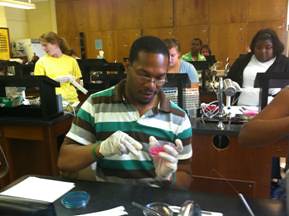Almost three years ago, two biology professors at Delta State University in Mississippi brainstormed how to give science undergraduates research experience in microbiology and entomology.
They hit upon the idea of searching for “science gold” in the bellies of bugs.
Professors Tanya McKinney and Ellen Green received $40,000 through a grant for under-represented colleges from the U.S. Forest Service to help with the project. As part of their research experience, students in the program search the guts of beetle larvae to discover new cellulases, enzymes that break down cellulose, an organic compound that helps make plant cell walls rigid.
“They (students) crack open logs and extract beetle larvae that they then dissect. They’re looking for the microbes in the larval digestive tract that make cellulases, enzymes that break down cellulose in tree cell walls,” Green said. “Though beetle larvae feed on wood, they don’t actually have the enzymes to digest it, so they rely on microbes.”
Used in the paper and pulp industry to break down wood fiber, cellulases are showing promise in the fermentation of woody biomass into biofuels, although this process is still in the experimental stage.
Woody biomass is described as byproducts of forest management, such as limbs, tops, needles, leaves, and other woody parts of trees and woody plants.
“If we find new cellulases that are even a little more efficient that would be a big deal,” Green said. “These enzymes could be key to making the process of turning wood into fuel efficient and economical.”
McKinney said the experience the students receive is invaluable.
“Students get to experience what real scientists do on an everyday basis,” she said.

McKinney’s microbiology class and Green’s entomology class worked on the project together. As a result, McKinney’s microbiology students picked up some entomology and Green’s entomology students picked up some microbiology skills.
“We were very fortunate to get funding from the Forest Service’s Southern Research Station Partnership Enhancement Initiative grant,” Green said. “It allowed us to design a research experience that we could incorporate into the classroom and reach as many students as possible.”
Green and McKinney worked closely with Nathan Schiff, research entomologist with the agency’s Center for Bottomland Hardwoods Research. Schiff participated in classes and attended scientific meetings with project students.
“They were quite enthusiastic and seemed to be getting an understanding of the scientific method,” said Schiff. “They seem more advanced than I was at this stage, and I expect that some of them will turn to a career in research.”
